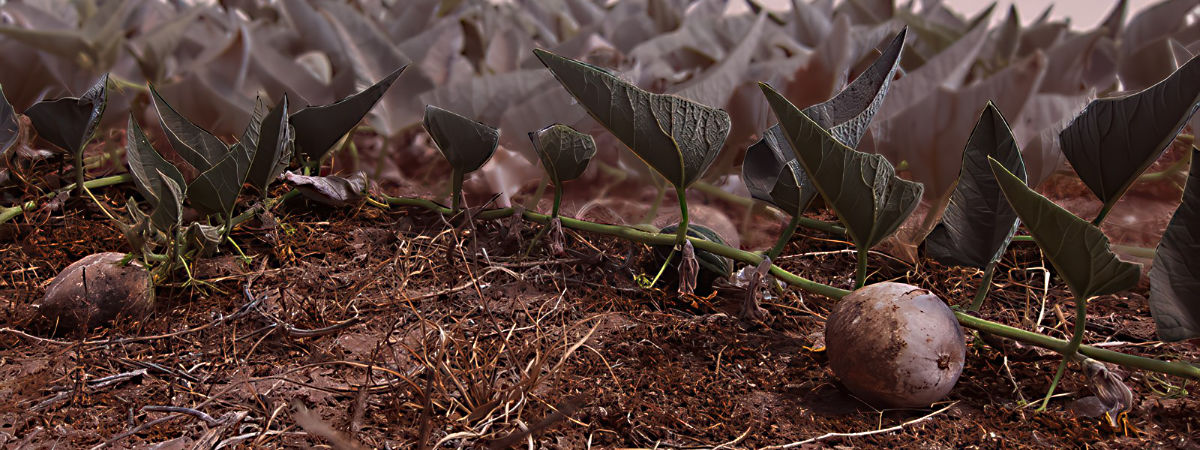Debbie and I are cantaloupe aficionados (as opposed to being connoisseurs — I’m sure you know the difference), having spent some or much of our formative years close to the cantaloupe capital of the world: Pecos, Texas. We both graduated from Fort Stockton High School, which is a tad more than fifty miles south on US 285. I’m loathe to disparage Pecos as having little to recommend it, although I suspect even longtime residents wouldn’t dispute that it could stand a bit of civic refreshing.
Anyway, for decades Pecos produced some of the sweetest, tastiest cantaloupes on the planet and we always looked forward to the short window in the hot summer months when they would become available. Ironically, even though we were practically nextdoor neighbors to Pecos, at least in West Texas terms, our access to the melons wasn’t as robust as you might expect, as national grocery chains tended to deplete the supply. A lot of our purchases came from local individual vendors selling aesthetically imperfect fruit from their truckbeds.
Why were Pecos cantaloupes exceptional? Here’s the explanation, excerpted from a 2012 report:
This spring, I went to Pecos to see what made the melons so good, where they are really from, and what has caused annual plantings to plummet from a peak of roughly 1,800 acres in the early 1990s to about 100 acres today. I talked to a dozen active and retired cantaloupe farmers and agricultural extension specialists, and I learned that the traditional Pecos cantaloupe has a small seed cavity and a corresponding abundance of orange flesh. The flesh’s peculiar sweetness is created by a combination of the potassium in the soil in which the cantaloupes are grown and the long hours of dry sunshine that nourishes them, abetted by the magnesium and calcium salts in the water with which they are irrigated.
Roland Roberts, a retired High Plains vegetable specialist for the Texas Agricultural Extension Service, says potassium favors the accumulation of sugars in the melons, and the salinity of the water prevents them from absorbing too much moisture, which would blunt the sweetness.
Source: “The Truth About Pecos Cantaloupes” — Texas Co-Op Power — July, 2012
Fast forward to today. Almost no cantaloupes are grown in Pecos, and haven’t been for years, due to a variety of environmental and economic factors. But one can still find them in small quantities, advertised and labeled as “Pecos Cantaloupe,” even though they’re actually grown in Coyanosa, about 30 miles southeast of Pecos. There the Mandujano Brothers Produce company grows watermelons, pumpkins, onions, hay, peppers, and, last but certainly not least, cantaloupes. Only a very small percentage of the several thousand acres under cultivation are dedicated to cantaloupes because, as they say, it is one of the hardest crops to grow.
You’re surely wondering how they can label their cantaloupes as “Pecos cantaloupes” when they’re not grown in Pecos. I don’t know whether any licensing issues are involved — I sorta doubt it — but a perhaps little known fact is that Coyanosa is located in Pecos County, while the city of Pecos is not (it’s the county seat of Reeves County). So, the nomenclature is still accurate, if tethered by a slightly different geographic anchor.
All of this is simply an introduction to the real subject of this post. We’ve purchased several “Pecos cantaloupes” this summer from our local HEB grocery store, with mixed results. Selecting truly delectable cantaloupes is an art that we’ve yet to master; we rely on the sniff test and our noses are not infallible. We’re batting about .500, with a couple of really terrific melons, a couple more that are sort of meh, and a couple that we regretted buying. (I’m rounding all of that to .500, in case you’re checking my math.)
On Monday, we bought one of the regrettable samples. After trying it and finding it wanting, Debbie decided to throw the pieces over the back fence for the benefit of any critters that are less judgmental than us, which, unsurprisingly, turns out to be all of them.
I mounted a trail camera on a tripod and pointed it through the fence at the general area where she tossed the cantaloupe early last Tuesday, and set it to record a photo and a short video of anything that appeared. Here’s a short video compilation of who showed up for the buffet.
A whitetail doe was the first to discover the bounty, but she was a bit camera-shy, having noticed the infrared flash of the camera and making a quick exit. A couple of hours later, a raccoon appeared and while it, too, noticed the flash, it obviously didn’t feel threatened. Finally, a few hours after that, a fox showed up and grabbed what was likely the last piece or pieces of the melon.
We may have been disappointed with the cantaloupe for our own consumption, but it was fun to see that our local wildlife seemed to be happy with the unexpected treat.
Closing Shot: All you have to do is look.

Discover more from The Fire Ant Gazette
Subscribe to get the latest posts sent to your email.


Luv this! Very informative for a former West Texan who loves Pecos cantaloupe!
It’s kind of sad the way the cantaloupe agribusiness has withered over the decades. According to one of those articles I linked to, one farm was shipping 40,000 crates of cantaloupe nationwide some 50 years ago. At least we can still occasionally get them from HEB.
I’ve seen several “Pecos” melons advertised up here in DFW. I didn’t go chasing them as I’ve been fooled so often. Daddy used to stop along the highway coming home from work and buy them!
Sherry, that’s probably wise. I trust HEB’s labeling but I’d be suspicious anywhere else. It’s sort of like in the Hill Country where there are a lot of roadside stands advertising “Fredericksburg Peaches” but they’re not even close to F’burg. But I will say that those Pecos County “truck bed fruit stands” were pretty reliable back in the day!